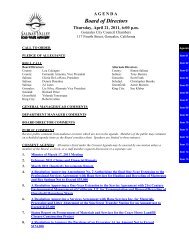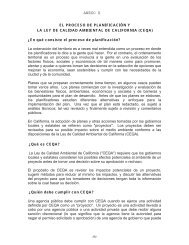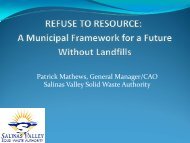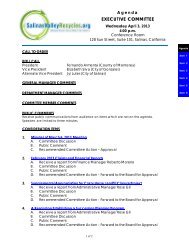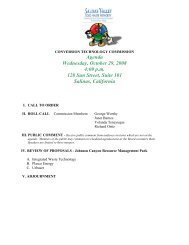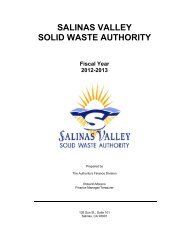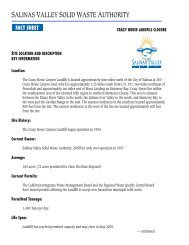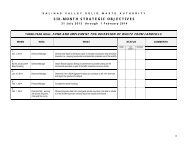Patrick Mathews, General Manager/CAO Salinas Valley Solid Waste ...
Patrick Mathews, General Manager/CAO Salinas Valley Solid Waste ...
Patrick Mathews, General Manager/CAO Salinas Valley Solid Waste ...
- No tags were found...
Create successful ePaper yourself
Turn your PDF publications into a flip-book with our unique Google optimized e-Paper software.
MSW-based integrated biorefining system for the production of liquid biofuelsKevin M. Holtman, Diana Franqui-Espiet, David V. Bozzi, William J. Orts, Gregory M. GlennIntroduction• Municipal solid waste (MSW) is comprised of residential andcommercial refuse.• 250 million tons are produced annually in the U.S.• ~80 million tons of MSW are cellulosic wastes available forbiofuel production.Figure 1. Photos of autoclave operation from top left , a) MSW being loaded into autoclave; b)MSW in autoclave prior to processing; c) MSW after processing; d) Trommel screen;e) Pulp fiber after Trommel screen; f) Hydrocyclone cleaned pulp.Autoclaving MSW• Autoclaving uses only water and can be considered a “green”transformation process.• Pulp can be isolated after autoclaving by a simple rotary screen.(Table 1)• ~84 % of all organics in MSW are captured in the accepts bin.• Hazardous hand sorting of raw garbage is eliminated.• Hazardous “leachates” can be collected for disposal.• Landfill volume can be reduced as much as 80-90 %.IncomingMSW3/8”ScreenAccepts1”ScreenAcceptsOvers(> 1”)% pulp/paper 31.7 93.0 15.8 3.4% woody material 6.5 1.7 8.6 1.2% fines 4.5 1.9 1.4 0% plastic 15.5 1.3 21.9 36.0% glass 4.0 1.0 18.1 0% metal 3.6 0 3.6 14.0% C&D <strong>Waste</strong> 5.9 0.8 16.3 7.7% solid food waste 10.2 0 1.8 0.8% rubber/leather/textiles 17.4 0.4 12.5 36.9% total 99.3 100 100 100Table 1. Component breakdown of incoming garbage and streams separated by theTrommel screen.UntreatedMSWVOCs totreatment/disposalPolishedprocesswaterAutoclaveLarge wasteto landfillTrommelscreen1”acceptsGasificationRecyclablesMSWpulpProcess energy and steam/Electricity to gridPulpCleaningEnzymaticHydrolysis/FermentationUnreactedsolidsFWGlucosePolishedprocesswaterHeavyrejectsDistillationBottoms<strong>Solid</strong>sSeparationAqueousphaseAnaerobicDigestion/PolishingBiogas(CH 4 )Ethanol todistillationScheme 1. Simplified flow diagram for the MSW-based biorefinery. Model depicts theenergy sources produced by segregation of the different components of MSW.Integrated Biorefinery• An integrated biorefinery can divert virtually all organics from thelandfill.Excessto sewer• ~50 % of the cellulose in the pulp fraction can be converted toethanol without further pretreatment.• ~ 14 MM gal/yr of ethanol can be produced directly fromprocessing 3000 tpd MSW.• Remainder of organic fraction can be gasified to produceprocess steam/electricity and sell electricity back to the grid.• Food waste and other soluble organics are anaerobicallyfermented to methane.• Anaerobic digestion polishes process water for reuse.• Recyclables are readily collected and combustible wastesare gasified to produce energy.Aqueous pretreatment of MSW• Liquid hot water pretreatment and steam explosion are“green” technique and can improve hydrolysis yields to80-90 % of theoretical. (Figure 2)• Since no chemicals are used, these techniques arecompatible with the rest of the integrated biorefinery.• Pretreatment can increase the yield of ethanol to~30 MM gal/yr on a 3000 tpd basis.• Aqueous pretreatment can also improve the degreeof hydrolysis of wastes such as rice straw.% Conversion of glucose1008060402000 10 20 30 40 50 60 70 80Incubation time (h)195 C, 45 min 205 C, 10 min 215 C, 4 min 225 C, 0 minFigure 2. Optimal residence times at given temperatures provide maximum %conversion of available glucose for the unfractionated MSW.Economics• MSW provides economic justification for building a biorefinerydue to its good ROI and relatively small payback period.• MSW is produced year round and provides a realistic substratethe biorefinery.• Transportation costs are low because it is already collected.• MSW is produced near population centers and brought to acentral facility for processing.RevenueElectricity, $/yr $ 2,404,012Ethanol, $/yr $ 32,850,410Tipping fees for diversion, $/yr $ 34,783,636Recyclables, $/yr $ 313,727Total revenue, $/yr $ 70,351,786PROFITS, $/yr $ 49,717,624Economic IndicatorsNPV @ 10 % discount rate, $ $ 104,815,859IRR, % 16.2Annualized ROI, % 16.8Payback Period, yrs 5.8Table 2. Revenue flow and economic indicators for the 3000 tpd biorefinery.Incorporation of ag-waste• Ag-waste can be incorporated seasonally into an MSW-basedbiorefinery, alleviating the tight operating margins for atraditional biorefinery.• Cellulosics such as rice straw can be converted to ethanol ata 50-60 % efficiency.• Other ag-wastes such as spinach are largely solubilized in theautoclave and readily fermentable to methane.• Autoclaving serves as a perfect alternative for tainted orexpired food crops.



